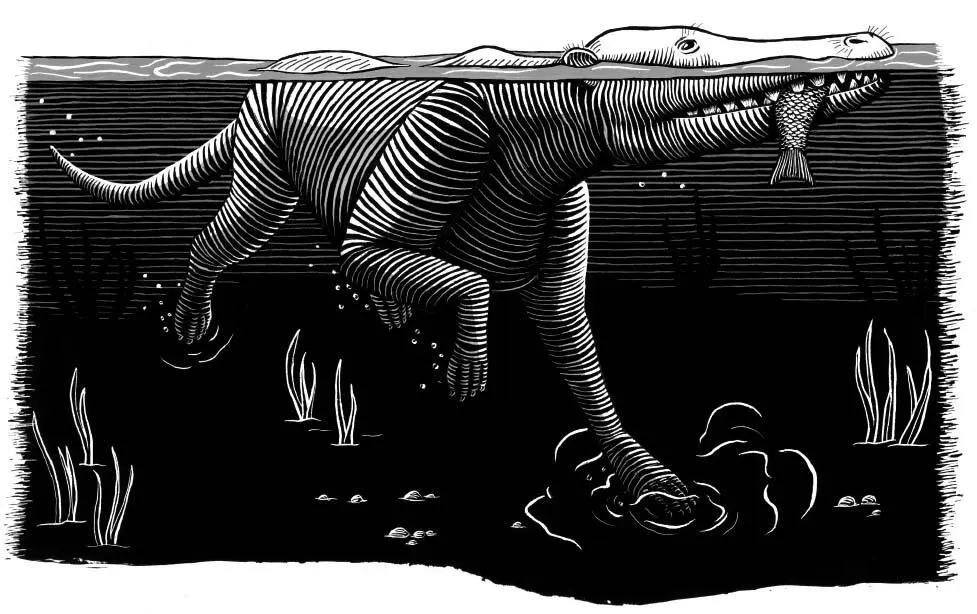I don’t malign whale huggers and dolphin lovers, even if I wrinkle my nose at the rhapsodic celebrations of armchair experts. Yes, whales and their lives are superlative, foreign, and well worth epic prose. But their amazing qualities are just starting points for me, as a scientist. Whales aren’t my destination: they are the gateway to a journey of discovery, across oceans and through time. I study whales because they tell me about inaccessible worlds, scales of experience that I can’t feel, and because the architecture of their bodies shows how evolution works. By rock pick, knife blade, or X-ray, I seek the corporeal evidence they provide—their fossils, their soft parts, or their bones—as a tangible way to anchor questions that surpass the bounds of our own lives. Whales have a past that reaches into Deep Time, over millions of years, which is important because some features of these past worlds, such as sea level rise and the acidification of ocean water, will return in our near-future one. We need that context to know what will happen to whales on planet Earth in the age of humans.
Whales are so very unlike the furry, sharp-eyed, tail-wagging, baby-nuzzling animals we think of when it comes to our mammalian relatives. First off, whales are among the few mammals that live their entire lives in the water. The only fur to be found on their bodies is the hairs that dot their beaks at birth. Although whales possess the same individual finger bones that you and I do, their phalanges are flattened, wrapped together in a mitt of flesh, and streamlined into bladelike wings, no hooves or claws to mar their perfect hydrofoils. Hind limbs exist only as relics in a handful of species, bony remnants tucked deep within muscle and blubber. A whale’s backbone ends in a fleshy tail fluke, like a shark’s; but unlike a shark or even a fish, whales swim by flexing their backbone up and down, not side to side. In short, they look nothing like squirrels or monkeys or tigers, but whales still breathe air, give birth, nurse their young, and keep company with one another over their lifetimes.
Fossils tell us the earliest whales were more obviously, visibly mammalian. The first whales had four legs, a nose at the tip of their snout, and maybe even fur (up for some debate among paleontologists, as fur doesn’t readily fossilize). They had sharp, bladelike teeth and lived in habitats that ranged from woodlands with streams to river deltas, occasionally feeding in the brackish waters of warm, shallow equatorial coasts. The oldest fossils of these land-dwelling, four-legged ur-whales come from rock sequences around about fifty million to forty million years old in the mountain ranges of Pakistan and India. At the time, the Indian subcontinent had not yet collided with Asia and sat in the middle of the forerunner to the Mediterranean Sea, called the Tethys sea, which split the Old World at the equator.
The skeletons of most of these first whales were the size of a large domestic dog. Because they lived on land, you won’t find the flattened arm and finger bones we see in whales today—instead their limb bones are round and weight bearing, and their hands and feet end in elegant, delicate phalanges. Their tail, as far as we can infer from the available bones, did not end in a fluke. Their Latin names give some clues about their provenance or what makes them special. Pakicetus , for example, originates from an area that is now Pakistan, but was once an island archipelago where early whales climbed in and out of streams. Ambulocetus , a low-slung early whale with body and skull proportions like a crocodile, has a name that translates as “ambulatory, or walking, whale.” Maiacetus , one of the rare early whales for which we have a near-complete skeleton, earned its name from fetal bones preserved near the abdominal cavity of the original specimen—the mother whale. Today’s whales all give birth tail first; the rear-facing position of the fossilized fetal Maiacetus showed that whales at this evolutionary stage still gave birth on land, headfirst.
The combination of four legs, phalanges, and cusped teeth is found in no whale alive today. What made these ancient creatures whales in the first place is subtle, lodged deep in their skeletons. That’s a good thing for us because these hard parts stand a chance of being preserved over tens of thousands of millennia. One of the most important features is the involucrum, a fan-shaped surface on the outer ear bone, rolled like a tiny conch shell. Pakicetus has an involucrum, as does every other branch on the whale family tree subsequent to it. The involucrum is one key trait, along with small clues in the inner ear and braincase, that the earliest whales share exclusively with today’s whales and no other mammals. In other words, it’s a feature that makes them whales and not something else. It’s unclear whether the trait gave Pakicetus an advantage for hearing on land, but later lineages of early whales co-opted it to hear directionally underwater, using a connection between the outer ear bones and the jawbones. Tens of millions of years later, the involucrum (and underwater hearing) persists in today’s whales, from porpoises to blue whales.

Pakicetus, a land dweller, swims in an Eocene streambed.
Fifty million years of whale evolution can be split into two major but unequal phases. The first deals with the transition of whales from land to sea in less than ten million years; the earliest land-dwelling whales all belong in that first phase—even at their most aquatic, they still retained hind limbs that could have supported their weight on land. The second phase covers everything that happened once whales evolved fully aquatic lives, for the remaining forty or so million years, until today. Throughout both of these phases, extinction dominates as a constant background theme because, as with the vast majority of animal lineages on the planet, most all the whale species that ever evolved are now extinct. While they are the most diverse marine mammal group today, numbering over eighty species, the fossil record documents over six hundred whale species that no longer exist.
The first phase of whale evolution is fundamentally about transformation: the tinkering and repurposing of structures from an ancestral state (originally for use on land) to a new one, in aquatic life. Transformation requires an initial state, and some starting points in evolution can be difficult to discern. For example, hearing, sight, smell, and taste are all senses that evolved for nearly 300 million years on land before the first ancestors of whales took to the sea. While it’s convenient to think of the reshaping of hands into flippers in whales as an undoing, that’s a mistake: whales didn’t undo 300 million years of terrestrial modifications. They did not, for example, recover gills. Instead, the story is far more interesting. Whales worked with what their ancestors had as land animals, modifying many anatomical and physiological structures for a new use rather than some phantasmagoric evolutionary reversal.
The second phase, after whales got back in the water, encompasses any whale lineage obliged to spend its life exclusively in the water; this phase also spans all of the consequences that arise from that constraint. You can think of evolutionary innovation as a hack on constraint. In other words, novelty in evolution is the appearance of a totally new structure, such as baleen, that confers not just a slight advantage to those who possess and inherit it but shifts their descendants into a completely new dimension of adaptation. The second phase of whale evolution, when innovations such as filter feeding and echolocation appear and fuel the diversification of today’s whales, stretches in time from the first aquatic whales, about forty million years ago, to the present day, including all living cetaceans, along with hundreds of extinct forms in between.
Читать дальше













